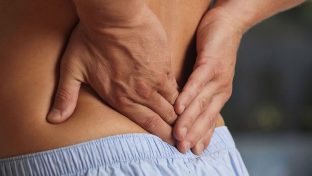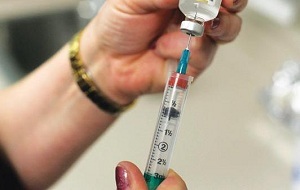Osteochondrosis of the lumbar spine, the symptoms and treatment of which are different, is one of the most common pathologies of the musculoskeletal system.
This condition is characterized by the development of degenerative-dystrophic changes in the intervertebral discs, which over time spread to the ligaments and bone tissue of the vertebrae of the lumbosacral spine. An acute process, in the absence of therapy, inevitably turns into a chronic one.
Degenerative disease can transform a healthy person into a disabled person.
Degrees of osteochondrosis of the lumbar spine
Classify 4 degrees of osteochondrosis of the lumbosacral region. The pattern of development of the disease is as follows:
First degree.In the inner part of the fibrous ring, lesions form in the form of cracks, where the contents of the nucleus pulposus penetrate causing irritation. This is the initial stage of osteochondrosis. The deformation of the intervertebral discs is barely expressed and gives reflex pain with sudden movements and heavy lifting. Unpleasant sensations in the lower spine can be mild and obvious:

- lumbodynia - local and lasting pain in the lumbar spine;
- low back pain - sudden and painful "back pain" in the lower back.
Second degree.The destructive processes in the annulus fibrosus continue. The distance from one vertebra to another decreases, causing compression of the nerve fibers. There is discomfort in the lower third of the back, which sometimes develops into bouts of pain.
Third degree.During this period, the final destruction of the fibrous ring occurs with the extrusion of the nucleus pulposus. The vessels and nerve endings are compressed by the intervertebral discs. An intervertebral hernia is formed. The spine is curved, forming:
- lordosis - arched deformity in the lumbar spine, with a forward swelling of the spine;
- kyphosis: the position opposite to lordosis, when the arch is formed in the outward direction;
- scoliosis: pathological bending of the spine to the right or left.
Last degree osteochondrosisis considered the most serious and dangerous. At this time, the spine is already deformed, normal physical activity is lost. X-rays show bone growths in the lumbar spine - the body's response. Pain may be absent for a while, but that doesn't mean improvement. People with stage 4 osteochondrosis of the sacro-lumbar spine often become disabled. The reason is that the process is complicated at this stage.
Causes of osteochondrosis of the lumbar spine
Among the causes of lumbar osteochondrosis are the following:
- Disproportionate load on the spine.Man is an upright creature, therefore, in an upright position, the load on the spine is considered normal. When performing various actions, it is necessary to move, bend and bend. To keep the body in the desired condition, the musculoskeletal system is in a prolonged tension mode. In a sitting position, the load on the spine increases, and when lying on the back it becomes minimal. When a person is in one position for a long time, the lumbar and sacral parts of the spine are overloaded and the muscles do not rest, from which there is first a feeling of discomfort and then pain. This deformation factor creates the prerequisites for the development of osteochondrosis of the lumbar spine.
- Sedentary lifestyle.It contributes to the development of various diseases, including those affecting the vertebral structures. Prolonged sitting causes deformation of cartilage tissue and a decrease in muscle tone, resulting in the development of lumbar osteochondrosis.
- Excessive physical exertion.Both the lack of vigorous physical activity and its excess do nothing good for the musculoskeletal system. Long and hard work, especially associated with lifting and carrying weights, leads to an overload of the back muscles and causes the formation of vertebral hernias.
- Posture disorders.The deformation of the discs between the vertebrae can also be caused by improper walking. The reason is again in the uneven load on the spine. The intervertebral discs lose elasticity, mobility and therefore are more likely to be damaged. More than others, people of advanced and advanced age suffer from similar problems.
- Bone defects, hereditary pathologies, trauma and infectious lesions.Often osteochondrosis is a consequence of disorders of the musculoskeletal system that were present at birth. For example, when the cartilage tissues of the body are naturally fragile. In addition, pathologies of the spine develop after traumatic injuries and infectious processes, as in osteomyelitis and tuberculosis.
- Flat feet.Signs of a "special" foot: absence of a notch and lowering of its arches. Those who have such a feature often face problems with the spine. This is due to the increased load on the intervertebral discs during walking. Throughout their lives they are subject to increased physical stress during movement, so they wear out quickly
- Obesity.Excess weight is a problem and an additional burden for the body. All organs and systems suffer, including the spine.
- Pathological processes.Dysfunctions of various structures can adversely affect the condition of the musculoskeletal system. So the factors that provoke osteochondrosis of the lumbar spine are endocrine disorders, cardiovascular problems and malfunction of the digestive system.
- Wrong lifestyle.Many people don't pay enough attention to simple and important things like physical activity, a balanced diet and normal sleep. An organism that has existed for a long time under stressful conditions becomes weakened and vulnerable. Among the other pathologies that can arise on such "fertile" soil, it includes lumbar osteochondrosis.
Symptoms of osteochondrosis of the lumbar spine

Pathological changes in the lumbar spine are manifested by severe symptoms;
- Low back painis the clearest "signal" of the development of lumbar osteochondrosis. Talk about the presence of "root syndrome", when compression of the nerve endings of the spine causes pain in the lumbar region. The person becomes tired and irritable. Over time, doing simple, routine activities becomes a big deal due to lumbar spine pain. If an intervertebral hernia has formed in the lumbar region, the pain radiates to the lower leg, back of the thigh and foot. Over time it becomes more and more difficult to sit and walk. Unpleasant sensations do not let go even when lying down. Temporary relief can alternate with periods of exacerbation.
- dysfunction of the genitourinary system.They are manifested by pain in the kidney area, frequent urination. The deformation of the intervertebral discs causes displacement of the lumbar spine relative to the sacrum. This affects the work of the internal reproductive organs in women and men causes problems with potency;
- decreased sensation of the legs in the foot area.It can be partial or absolute. This weakens the reflexes of this part of the body. Progressive pathology leads to a complete loss of sensitivity of the lower limbs;
- gait disturbances.Lumbar spine pain with osteochondrosis causes a person to drift when walking in the opposite direction to where nerve fibers are pinched. The condition does not allow you to travel long distances. A lame person is forced to stop from time to time, expecting pain relief. Prompt medical assistance can save a person from disability.
Treatment of osteochondrosis of the lumbar spine
Many people wonder if osteochondrosis of the lumbar spine is treated and how it manifests itself. When the diagnosis is made and the diagnosis is made, therapeutic tactics are determined.
There are various methods by which lumbar osteochondrosis is treated. Which of them is necessary and advisable to apply to cure a disease or alleviate the condition of a person as much as possible, determines the doctor.
Someone is treated exclusively with folk remedies, at home, forgetting that they can only be used with the approval of a specialist doctor and only as part of complex therapy.
Medicines for osteochondrosis
Drug therapy involves the use of:
- tablet modules;
- solutions for injection;
- preparations for external use - ointments and gels.
Drugs are prescribed that eliminate inflammation and relieve pain in the lumbar spine. They can be used at home.

These could be:
- analgesics;
- non-steroidal anti-inflammatory drugs;
- medicines for muscle spasms (muscle relaxants);
- means for the restoration of cartilage tissue (chondroprotectors);
- corticosteroids (drugs containing hormones that work to relieve pain and inflammation)
- vitamins.
The course of treatment is prescribed by a doctor, who sometimes prescribes pills or potions to calm the nervous system as an additional treatment.
Physiotherapy for lumbar osteochondrosis
Physiotherapy is another common method of relieving the symptoms of lumbar osteochondrosis. By acting on the spine and lumbar, it promotes metabolic and repair processes.
Most often prescribed:
- magnetic, laser and electrotherapy;
- phonophoresis;
- shock wave method;
- detensive therapy;
- vibratory massage;
- balneotherapy.
How many and which procedures will be needed - the doctor decides.
Physiotherapy is effective when it comes to the initial stages of the disease. But she, like other types of treatment, has contraindications. Therefore, when prescribing this method, the doctor takes into account many factors.
Therapeutic gymnastics for lumbar osteochondrosis
A series of physical exercises that can be shown for lumbar osteochondrosis is aimed at restoring the mobility of this spine.
Regularity is considered the main condition for its effectiveness. Exercises performed occasionally will not bring the desired effect.
If the body already has complications caused by osteochondrosis, this method is not applied. In addition, contraindications to its use are severe pathologies of other organs and systems, as well as the presence of pain in the pelvic region and beyond.
Surgery for osteochondrosis of the lumbar spine
The surgical method is used in the presence of such serious complications as an intervertebral hernia. Partial or complete removal of the damaged intervertebral disc (discectomy) is performed, as per the protocol of the operation.
The indications for surgery are:
- severe and persistent pain syndrome, which cannot be removed with drugs for a month;
- the large size of the hernia and its effect on the spinal cord.
Osteochondrosis is easier to prevent than to cure. Like any pathology, it is potentially dangerous with serious complications. It is important to understand that the more or less complete elimination of this pathology is possible in the early stages, when the deforming effect on the intervertebral discs is minimal. In other cases, we can only talk about relieving symptoms and maintaining the state of the body, which allows you to live and work normally.













































